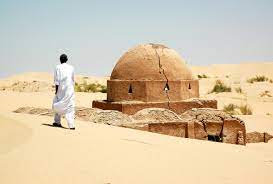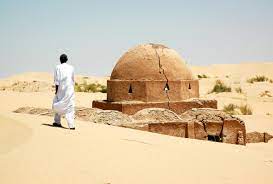This post defines cultural heritage, discusses the cultural heritage of Algeria and the heritage sites of Algeria.
Cultural heritage is the heritage of tangible and intangible heritage assets of a group or society that is inherited from past generations.
Algeria enjoys a rich arts and crafts history. It is notoriously known for its intricate carpet weaving and delicate pottery work, and has a long tradition of excellence in wooden sculptures, Copperwares, Ceramic art, basket making and jewelry design.
Algeria has a number of fine museums, most of which are located in the capital and are administered by the Office of Cultural Heritage (1901). The National Museum of Antiquities (1897) displays artifacts dating from the Roman and Islamic periods. The National Fine Arts Museum of Algiers (1930) houses statues and paintings, including some lesser works of well-known European masters and the Bardo Museum (1930) specializes in history and ethnography. Most other cultural institutions also are found in Algiers, including the National Archives of Algeria (1971), the National Library (1835), and the Algerian Historical Society (1963).

There are 7 Heritage Sites in Algeria. The sites can be divided as follows: 6 cultural sites and 1 mixed site.
Al Qal’a of Beni Hammad (1980) Cultural Sites
Al Qal’a of Beni Hammad, also known as Beni Hammad Fort, is a fortified palatine city from the 11th century Algeria. It is one of the cultural sites under the list of Heritage Sites in Algeria. This fortified city is now in ruins and you will see what’s left of a 7-kilometer long line of walls. This fortified city served as the first capital for the Hammadid dynasty. When it was inscribed by UNESCO, it was referred to as the authentic picture of a fortified Muslim city”.
Within the 7-kilometer wall that makes up this city, you will find four residential complexes and the second largest mosque in Algeria. There have been many excavations done at the site and researchers were able to unearth various relics including coins, ceramics, jewels and terracotta.
Djémila (1982)
Djémila is one of the cultural Heritage Sites in Algeria. It was inscribed in 1982 and encompasses a small mountain village in Algeria. The property is home to the best preserved Berbero-Roman ruins in North Africa. Specifically, this site is recognized because of its ability to adapt to the mountain environment and how it adapted the Roman architecture style.
There are several preserved buildings but the most notable ones are as follows: theater, temples, two fora, arches, basilicas, houses and trees.
Kasbah of Algiers (1992)
Kasbah is an Algerian word that translates to citadel. It refers to the citadel of Algiers that the traditional clusters that surround it. The Kasbah of Algiers is a 60-hectare walled city that was founded on the ruins of old Icosium. This mid-sized city was established on a hill and towards the sea. There are several structures and buildings that were founded in the 17th century. Some of these structures include minarets, mosques, and palaces.
M’Zab Valley (1982)
The M’Zab Valley region is a cultural site inscribed into the list of Algeria’s Heritage Sites in 1982. It is located in northern Sahara and encompasses five traditional fortified villages. This region is preserved and recognized as a world heritage property because of its ability to exemplify traditional human habitat and adaptability to its environment. The original settlers built their homes here in the 11th century. The five villages that make up this site include El Atteuf, Bou Noura, Beni Isguen, Melika and Ghardaia.
Timgad (1982)
This is another Berberi-Roman town in this list of cultural Heritage Sites in Algeria. Specifically, it is located in the Aures Mountains of Algeria. Founded in 100 AD by Emperor Trajan, majority of this town has been preserved until today. The ruins of this ancient town can still be seen until today, specifically the Trajan’s Arch. The town is also one of the best extant examples of the grid plan that was used during Roman City planning of this ancient site.
Tipasa (1982)
Located along the shores of the Mediterranean, Tipasa is an ancient trading post that came under the rule of Ancient Rome. Eventually, the ancient town was converted into a strategic base during the conquest of the kingdoms of Mauritania. In this ancient town, you will find a wide collection of ruins depicting Roman, Phoenician, Byzantina and Paleo-Christian structures and monuments. You will find these structures and monuments co-exist with other indigenous monuments including the great royal mausoleum of Mauretania.
This 52-hectare property was inscribed into the list of cultural Heritage Sites in Algeria in 1982.
Tassili N’Ajjer (1982)
The Tassili n’Ajjer is the only mixed site in this list of properties in Algeria. Inscribed in 1982, this property encompasses a heavily eroded sandstone rock formation within the Sahara Desert. Within this site are more than 300 rock arches, gorges, steep cliffs, and eroded sandstone rock pillars. The entire property covered by UNESCO measures at 72,000 square kilometers.
Aside from this natural formation, the property is also an important archaeological site. Within these rocks, you will find several prehistoric parietal rock artworks. These artworks were first spotted in 1910 and have been dated back to the early Neolithic era.


